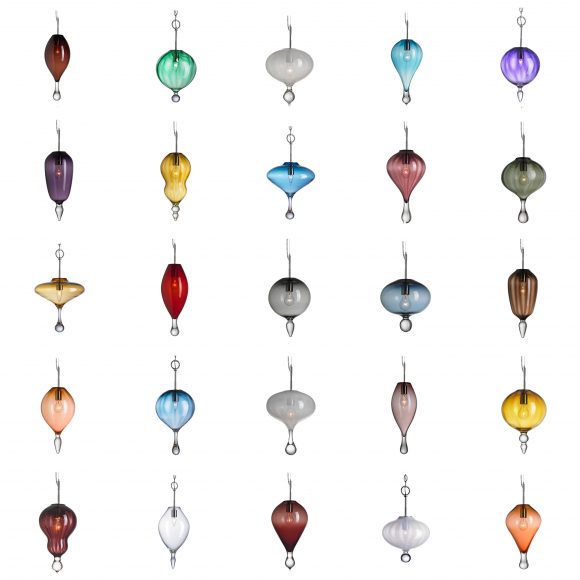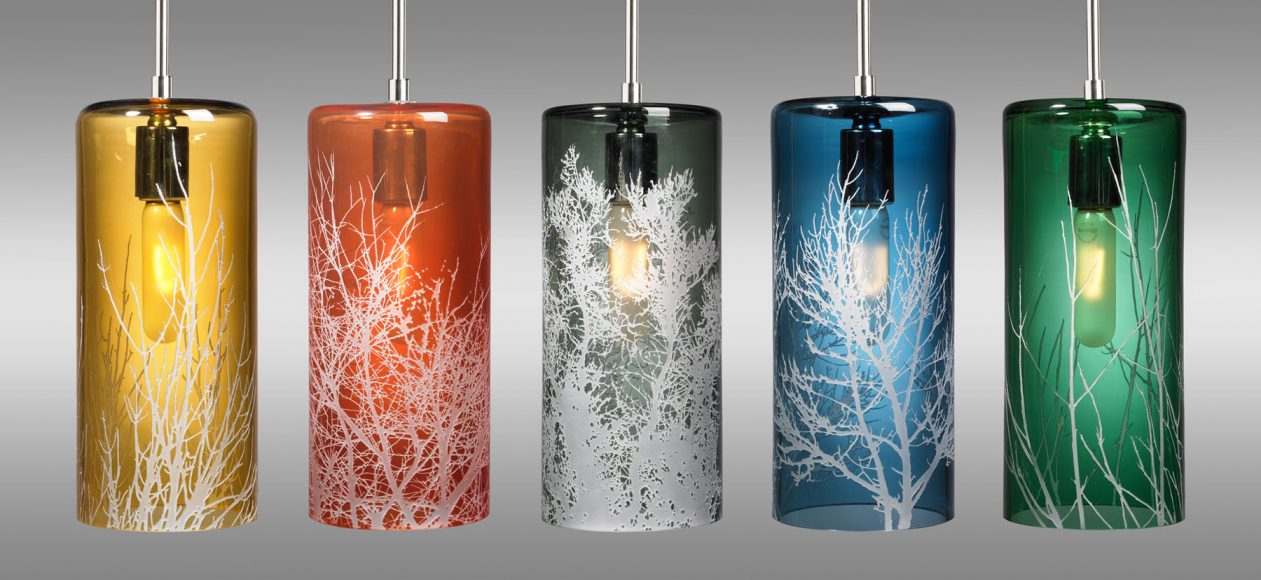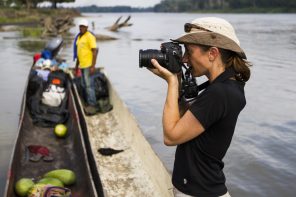For every one-of-a-kind lighting fixture in the Lake Purdys studio of Moshe Bursuker, there’s also a vase, bowl or piece of sculpture.
While the works may range from the artfully functional to the purely decorative, all share a common thread – they are reflections of the world of influences that go into the glass artist’s creations.
And each is as shimmering and unique as Bursuker’s own story. As the first in his family to pursue a career in the arts, Bursuker would train in various techniques, including classic Italian glassmaking, advance from the most functional projects to the most elaborate and most recently, go on to work with New York City architects and designers.
Throughout, the 36-year-old artist has developed a singular commitment to glassmaking that spurs him ever forward.
“It still fascinates me after all these years,” he says of the work he began at age 19.
EARLY DAYS
Bursuker’s parents were living in 1970s Russia, working in the science field, when they landed in Israel as part of a wave of immigration. Though Bursuker would be born there in 1978, the young family soon made its way to America for job opportunities. After a bit of moving about, the family finally settled in Cheshire, Conn., where Bursuker would spend the bulk of his childhood.
“I’m eternally grateful,” he says of the chances he had, from the exposure to the arts to the opportunity to pursue his blossoming love of both photography and sculpture.
Bursuker went on to earn a bachelor of fine arts degree in sculpture and photography from the Hartford Art School at the University of Hartford, where he first began to work with glass.
He also further trained and sometimes taught at places including some of glass’ finest educational centers, including the Pilchuck Glass School in Washington state (famed glass artist Dale Chihuly is one of the founders); Penland School of Crafts in North Carolina; and The Studio of The Corning Museum of Glass in upstate New York.
“My early days I was very much involved with learning and teaching and traveling to all these places,” Bursuker says.
He began his glass career by making what he calls “product-based designs,” such as vases, bowls and candleholders, always learning and advancing his skills.
“I studied Venetian techniques for years,” he says. “You can’t be a glassblower and not be inspired by Venetian glass.”
Today, there’s no limit to his work, thanks to both changes in the field and his own skills and interests.
“The only thing I’m really good at is blowing glass,” Bursuker says, with a smile. “That’s my one thing I can claim excellence in.”
And he loves that the field – both advances in technology and his own techniques – continues to grow.
“Now I’m being able to make things in glass that I’d never have thought of.”
THE WORK
Today, Bursuker works primarily out of three places – UrbanGlass in Brooklyn, GlassRoots in Newark, N.J., and the basement studio in his home of the last eight years, Lake Purdys.
Bursuker blows or casts his glass at those urban venues, with the finishing work – including grinding, cutting, polishing and sandblasting – completed in Westchester. It’s a functional space, one where his surfboard, a nod to his 15-plus years on the waters off Rockaway Beach, hangs in the background.
But it was back in 2000 when Bursuker moved to New York City and got down to business.
“I went to UrbanGlass, and they have a great model to help young professionals start their businesses,” he says. “I started assisting and working with all sorts of incredible glass artists.”
Founded in the late 1970s as the first artist-access glass center in the country, UrbanGlass is now considered the largest. Before its inception, those who wanted to work in glass had to do so through art schools, in factories or by building their own studios.
Bursuker can also often be found at GlassRoots, which gives young people the chance to learn both glassmaking and entrepreneurial skills.
Students, he says, learn by example.
“They’re seeing us in the studio making things,” he says.
Bursuker, it seems, is always making things, most recently more lighting and works that are integrated into interiors.
“It was 2008 or 2009 when I started working with a lot of architects and designers,” he says, primarily on “hanging art objects.”
Today, he adds, “I do a lot of manufacturing work for artists and designers.”
His studio on a recent morning, for example, is filled with hundreds of light fixtures destined for a Manhattan hotel.
“People are realizing they can have stuff fabricated right here. They can come in and work with me directly. There’s not shipping containers.”
Today, his signature lighting includes several models, from the organic droplets to the carved pendant lighting.
“The most challenging part in my opinion in lighting design is coming up with creative hardware solutions,” he says.
So what does he do? He designs his own, which he says has been “difficult and challenging but rewarding.”
“It’s another skill base,” he says. The more he learns, the more he can push the boundaries and translate his imagination into actual designs.
Bursuker continues to exhibit his work, as well. Locally, he was featured in the ArtFull Living Designer Show House in Cold Spring in 2012, while he’s recently been featured in a juried glass show at Gallery 66 NY, also in Cold Spring. He has also participated in numerous national shows, including the prestigious SOFA (Sculptural Objects Functional Art) + Design exhibition in Chicago.
“I have relationships with galleries across the country,” he adds.
In March, Bursuker’s booth was a popular destination at the Architectural Digest Home Design Show in Manhattan, a favorite showcase of his.
THE ART WITHIN
Though each piece of his lighting may indeed be uniformly functional, each is also, by nature, one of a kind. And that’s what, he says, people relate to.
“It’s not ‘a product,’” he says. “It’s really a work of art.”
To create his work, Bursuker uses “really high-quality glass that’s designed for artists.”
“It’s very different than your typical glass found in everyday objects.”
For any creation, he does lots of drawing by hand and renderings.
“Once I feel I have something that is going in a good direction, I’ll go into the studio,” he says.
But he’s open to whatever happens once he’s there.
“You can change it while you’re making it,” he notes.
When it comes to his more sculptural work, Bursuker says that is often based on his photography.
“I’ll shoot a series of photos,” he says, choosing a theme for inspiration. Then, “I’ll let these images inspire the glass.”
Sometimes he has a very clear idea of what something will be.
“Other times I’ll let the glass speak for itself and let it flow naturally.”
It sounds relaxing.
“It’s also really exciting,” he says. “It’s a nice way of working. It just flows out of you.”
But not every time is a success.
“It either works or it doesn’t,” he says, but that’s part of the process that is far from a solitary endeavor, especially in the blowing or casting stages.
“Everything in glass is a team,” he says. “None of the stuff I do is alone. I always have an assistant.”
It’s the way of glassmaking and also a way that keep the community connected.
“A lot of people compare it to dancing with people, where you’re doing two different things but you have to do it together,” he says. “If you’re off sync, it’s going to show. Just like anything. It’s a process.”
And it’s also a challenge, one that he never tires of.
“I could live three lifetimes and not do everything I want to do with glass,” he says. “You can devote your entire life to one particular technique and not know everything about it.”
But, he says, sharing knowledge is a big part of the glass community and the way he sees it.
“If there are less secrets among artists, as a community we’ll make better objects,” he says, noting that the American glass field is relatively young, having come into its own with the studio glass movement that took off in the 1950s.
SPECIAL RECOGNITION
Bursuker was recently selected as a member of the Silvermine Guild of Artists, a prestigious group of professional artists that traces its roots back to the early 1900s.
Jeffrey Mueller, the gallery director at Silvermine Arts Center in New Canaan, discusses the guild.
“The process started in the 1920s, based on the model of artists being juried in by their peers,” Mueller says.
Guild membership is open to all, though it reflects primarily New England artists. Many, Mueller adds, are from New York and Connecticut.
“We had first seen Moshe’s work in a trunk show we had here in the winter, and I fell in love with his work,” Mueller says.
He created, Mueller says, a “really beautiful installation,” he says of the multi-tiered presentation.
Mueller says he suggested he apply for guild membership, which Bursuker did. (And with that will come participation in the new member show next January). Artists, Mueller adds, give back to the center through working and exhibition and also benefit from The Knockers Club, a peer-critique program.
In addition to Bursuker’s work being visually captivating, there was more going on, Mueller says.
“One of the things that we noticed – and a lot of people described – is also the play of light in his objects,” he says.
From the start, Mueller was hooked and not only by Bursuker’s technique.
“Also, I think he had a lot of unique forms. … There’s something very sculptural about them in addition to being functional.”
It’s why, he says, the Bursuker vase he bought his wife looks just as lovely when standing empty on a shelf as when filled with blooms.
MOVING AHEAD
Bursuker keeps himself on a tight schedule, by necessity.
“Obviously paid client work takes priority,” he says with a laugh. “I don’t know how else to say it.”
Bursuker has “scheduled days” in the studio – which keeps him on target.
His artwork, which is also expanding to integrate glass into furniture design, is done in between.
Throughout, Bursuker nurtures a dream — to help create a glassworks within Westchester County. He sees it as being a place for artists to make glass, for students to learn about glass and for the public to come for exhibitions and sales.
“My goal is to have a glass-blowing studio attached to a showroom,” he says. “I don’t have a timeline on my goal. I think a lot depends on finding the place.”
For Bursuker, no matter where the work takes him, it’s all part of a steady progression.
“There’s definitely a direct relationship,” he says. “One design breeds the next and the next. … It will be interesting to see what happens a year from now.”
We’ll be watching.
For more, visit moshebursuker.com.







Mr. Bursuker, I tried to send you an invitation to the Country Childrens Center’s upcoming art auction, but it came back, marked “return to sender.” I assume the Purdys address is old. Please send me your new address and I will post you an invitation.
Thanks, Ric Peace